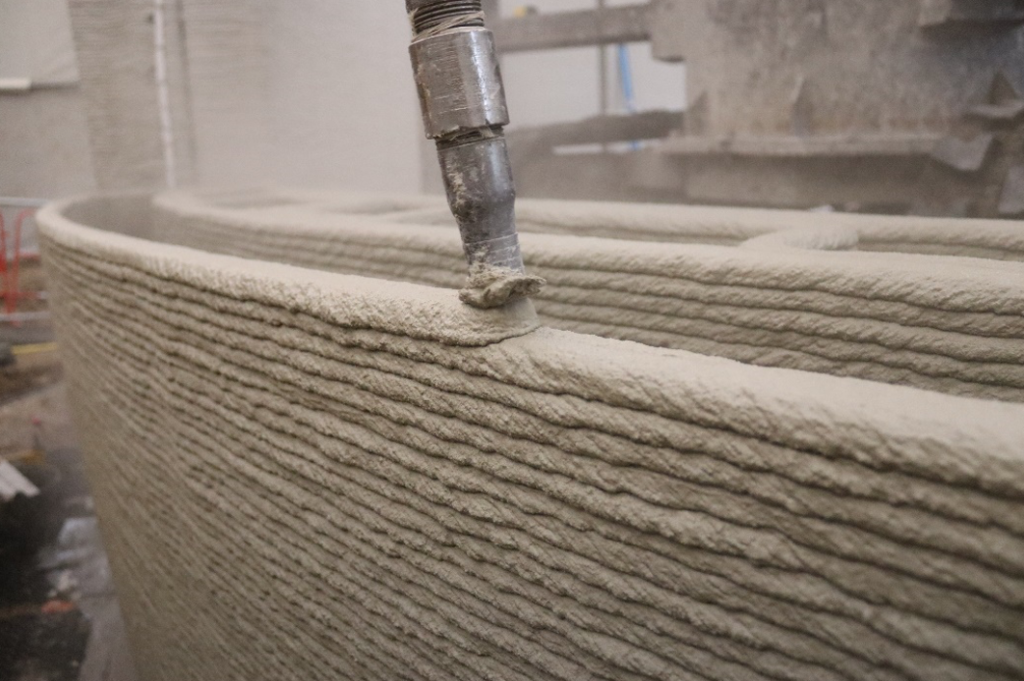3D Printing Helps Streamline the Construction Industry
New Demands in Construction Drive Innovation
Demand for new structures, buildings and housing continues unabated. This inevitably places pressure on the workforce and the materials required, the latter of which have a huge environmental impact. The cement/concrete industry alone is responsible for 5%-8% of global anthropogenic emissions.
3D concrete printing (3DCP) helps to address both above challenges simultaneously. The approach relies on the creation of a digital design, which is used to instruct a printer to produce a structure. Software supports the design of structures and conversion of the model for printing, while materials are under development which are optimized for printing applications. The result is:
- Reduced material usage
- Less demand for labor
- Lower construction costs.
3DCP can be applied both to precast and onsite construction, and there are also companies applying a combination approach. The printers themselves are either owned and operated by the manufacturer or sold to end users who operate the systems. Will 3DCP revolutionize the construction industry?
Systems Providers have Quietly Expanded Globally
COBOD is a leading provider of 3DCP printers and behind the first 3D printed building in Europe. We spoke to Founder, Henrik Lund-Nielsen about how the company developed their solutions in response to market potential of large format printing. The company does not execute projects, rather the technology is provided to customers who are free to source their own locally available materials. Global formwork provider, PERI saw potential in the company and became a minority shareholder in 2018. COBOD has since expanded into new markets and broadened its application. The second iteration of the technology launched in 2018 was used to print the first 2 and 3 story buildings in Europe in 2019 and 2020, respectively. Further, in June 2020 COBOD partnered with GE Renewable Energy and LafargeHolcim to co-develop 3D printed wind turbine towers. The turbines will increase renewable energy production while lowering the Levelized Cost of Energy and optimizing construction costs. COBOD doubled its year-on-year revenues in 2020 and order intake for 2021 is already twice last year’s intake. Henrik explained how, “It seems like our many large multinational customers are giving the market the confidence in the new technology we are providing, and in us as a credible supplier.”
Another European provider, CyBe Construction offers a fixed printer for off-site or precast applications, and a mobile printer for construction and precast. CTG spoke to Berry Hendriks at CyBe who explained how technologies including 3DCP are key to addressing labor and housing shortages, but challenges to adoption remain. CyBe took the approach to develop a full solution including software, hardware, and materials. Further, because of the knowledge gap, CyBe set up its own academy and contracting operations. Berry commented, “it’s not just about the technology, there is a need to educate people, innovate in procedures and processes as well.” The company now has customers around the globe and is self-supporting.

Paris-based XtreeE has many similarities to CyBe. The company provides a full system solution with hardware, software, and materials for construction and precast. We spoke to co-founder, Jean-Daniel Kuhn, who explained how the combination of new design and production techniques is critical and drastically reduces materials consumption and for XtreeE. “3d printing only really makes sense in construction if the way projects are made is revamped. For this reason, XtreeE Studio works closely with architects and engineers to redesign concrete elements.” Meanwhile, the company collaborates with materials producers, including through the Wool2Loop Project, to incorporate materials such as geopolymers and recycled aggregates which are less emissive. Founded in 2015 with backing from Vinci Construction, the company raised funding and renewed a development and marketing partnership with Lafarge in March 2021.
New Entrants are Operating throughout the Construction Cycle
The past months have seen 3DCP innovators attract large funding rounds – required because many new entrants operate throughout the construction cycle. Mighty Buildings is one such example. The company’s housing units are created with a 3D-printed exterior panelized shell while some elements are prefabricated in the company’s production facility in Oakland. Materials innovation remains a key theme also. The company invented a proprietary thermoset composite material called Light Stone Material (LSM) as part of its effort to reduce the home construction industry’s reliance on concrete and steel. The company raised a $40 million Series B round in February 2021 which will be used to scale production capacity with increased automation, and to build out their B2B platform for developers with sustainability as a core focus.
Another 3DCP innovator attracting investment is ICON, again a provider of homes with a focus on proprietary materials. ICON has developed its own Portland Cement-based mix that enables the ability to rapidly print homes. The company raised a $35 million Series A round in August 2020 with the funding earmarked for product development and hiring across robotics, off-planet construction, materials science, software engineering, architecture, building science, and operations departments. The investment brings total funding since launching to $44m.
Keep an Eye Out For
3D printing in construction doesn’t stop with concrete. New approaches and materials innovations such as those under development by Branch Technology are worth watching. The company’s printing method allows material to solidify in open space, creating a matrix of polymer in virtually any shape. Branch announced an $11 million Series B round in December 2020 to support commercialization of its Cellular Fabrication composite 3D printing process.
From concrete to composites, the optimization of technology, materials and design together will help to streamline construction processes and increase material efficiency. If the scale of recent expansions and investments are anything to go by, 3D printing has the potential to revolutionize the construction industry.


